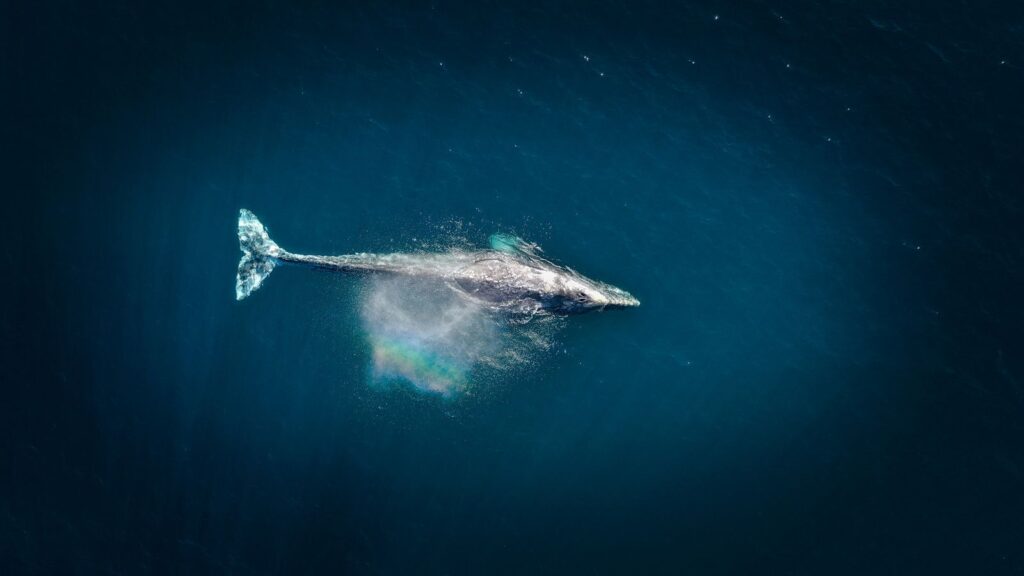Water spouting is a characteristic made possible by the blowhole, an anatomical feature of whales positioned on the top of their head.
Whales are mammals that can breathe. Because they can breathe but live in the water, they have adapted their respiratory system for marine life. Spouting is the forceful release of air and water vapour facilitated by the whale’s complex respiratory system.
Spouts can also help researchers understand whales’ health and vital signs. By examining whales’ spouts, size, and shape, researchers can gain insights into their health and the broader ecological dynamics.
Main Takeaway
- Whales spout water through their blowholes on top of their heads, allowing respiration in their aquatic environment.
- Blowholes serve as nostrils, with baleen whales having two and toothed whales having one. Muscles around the blowhole seal it during dives to prevent water entry.
- Whales expel carbon dioxide and inhale fresh air, causing a visible spout due to condensation.
- Spout visibility and features can indicate various environmental and physical conditions.
Species Variations:
- Blue Whales: Produce tall spouts (over 10 meters) visible from afar.
- Minke Whales: Have modest spouts around 3 meters high.
- Humpback Whales: Known for distinctive balloon-shaped spouts up to 3 meters high.
- Fin Whales: Generate strong, column-shaped spouts (4-6 meters).
- North Atlantic Right Whales: Characteristic V-shaped spouts up to 5 meters, crucial for species identification.

Anatomy of the Blowhole
The blowhole, serving as a whale’s nostril, is strategically located on the top of its head, enabling the mammal to breathe. This anatomical feature is essential for the whale’s survival in its aquatic environment, allowing for efficient respiration.
The blowhole’s structure varies among species; baleen whales possess two blowholes, while toothed whales have only one. This distinction in the number of respiratory tracts is significant in the taxonomy and identification of whale species.
The blowhole has strong muscles that can tightly seal when the whale dives. This action prevents water from entering the respiratory system during submersion. Upon reaching the surface, the whale opens its blowhole to expel accumulated carbon dioxide and inhale fresh air before submerging again.
When meeting the cooler atmospheric temperature, the expelled air often condenses and creates what is commonly referred to as the whale’s spout. Together with condensed air, there may be debris covering the hole and also mucus.
The visibility and characteristics of this spout can vary dramatically, influenced by environmental factors such as wind and humidity, as well as the whale’s physical activity.

Variations Among Species
Whale species exhibit diversity in the size and shape of their spouts, depending on their respiratory characteristics and the environments in which they live. Their size, anatomy, and behaviour also influence their spouts.
- The blue whale, the largest mammal on earth, produces a towering spout that can reach heights of over 10 meters and is visible from several kilometres away.
- Minke whales, which are considerably smaller, have more modest spouts, approximately 3 meters high.
- Humpback whales are known for their unique balloon-shaped spouts, which can soar up to 3 meters. This shape is distinctive and helps identify them from a distance.
- Fin whales generate a strong, column-shaped spout, approximately 4 to 6 meters tall, indicating their large lung capacity and rapid surfacing behaviour.
- North Atlantic right whales display a characteristic V-shaped spout, reaching up to 5 meters. This shape efficiently clears their dual blowholes and is a critical identifier for this endangered species.
Conclusions
Whales spout water through their blowholes, an adaptation that allows these marine mammals to breathe while submerged. Spouting results from their specialized respiratory system and varies across species, influenced by anatomy and environmental conditions.
Whales do not spout water but air, and the spout forms due to the impact of different air temperatures.



